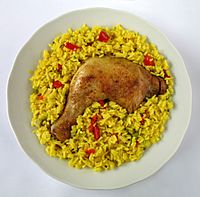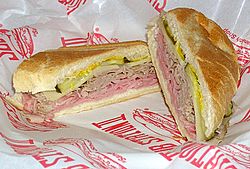Cuban cuisine facts for kids

Cuban cuisine is largely based on Spanish cuisine with influence from African and other Caribbean cuisines. Some Cuban recipes share spices and techniques with Spanish, African and Taino cooking, with some Caribbean influence in spice and flavor. This results in a blend of the several different cultural influences. A small but noteworthy Chinese influence can also be accounted for, mainly in the Havana area. There is also some Italian influence. During colonial times, Cuba was an important port for trade, and the Spanish ancestors of Cubans brought with them the culinary traditions of different parts of Spain.
Overview
As a result of the colonization of Cuba by Spain, one of the main influences on the cuisine is from Spain. Other culinary influences include the Taíno, the indigenous people of Cuba, Africa, from the Africans who were brought to Cuba as slaves, and French, from the French colonists who came to Cuba from Haiti. Another factor is that Cuba is an island, making seafood something that greatly influences Cuban cuisine. Another contributing factor to Cuban cuisine is that Cuba is in a tropical climate, which produces fruits and root vegetables that are used in Cuban dishes and meals.
A typical meal consists of rice and beans, cooked together or apart. When cooked together the recipe is called "congri" or "Moros" or "Moros y Cristianos" (black beans and rice). If cooked separately it is called "arroz con frijoles" (rice with beans) or "arroz y frijoles" (rice and beans).
Cuban sandwich
A Cuban sandwich (sometimes called a mixto, especially in Cuba) is a popular lunch item that grew out of the once-open flow of cigar workers between Cuba and Florida (specifically Key West and the Ybor City neighborhood of Tampa) in the late 19th century and has since spread to other Cuban American communities.
The sandwich is built on a base of lightly buttered Cuban bread and contains sliced roast pork, thinly sliced Serrano ham, Swiss cheese, dill pickles, and yellow mustard. In Tampa, Genoa salami is traditionally layered in with the other meats, probably due to influence of Italian immigrants who lived side by side with Cubans and Spaniards in Ybor City. Tomatoes and lettuce are available additions in many restaurants, but these are considered by traditionalists as an unacceptable Americanization of the sandwich.
After assembly, the Cuban sandwich may be pressed in a grooveless panini-type grill called a plancha, which both heats and compresses the contents.
List of Cuban dishes and foods

- Arroz con leche
- Arroz con maiz
- Arroz con pollo
- Arroz a la cubana
- Bistec de palomilla
- Boliche
- Buñuelo
- Butifarra
- Camarones
- Camarones enchilados
- Casabe
- Chiviricos
- Churros
- Croqueta
- Cucurucho
- Dulce de leche
- Empanada
- Flan de calabaza
- Flan de coco
- Flan de guayaba
- Flan de huevos
- Elena Ruz
- Frijoles negros
- Frita
- Fufú de plátano
- Guayaba
- Lechón
- Majarete
- Medianoche
- Mermelada
- Mojo criollo
- Morcilla
- Moros y Cristianos
- Natilla
- Papa rellena
- Papitas fritas
- Pasteles
- Pernil
- Picadillo
- Platano maduro frito
- Pudín de pan
- Pulpeta
- Ropa vieja
- Sandwich Cubano
- Sopa de pollo
- Tamal
- Tortilla de patatas
- Tasajo
- Torrejas
- Tostada
- Tostones
- Tres leches cake
- Turrones
- Vaca frita
- Yuca con mojo
- Yuca frita
List of Cuban drinks
- Batido - Milkshake coming in flavors such as guanabana and trigo (wheat)
- Cafe Cubano - Cuban espresso
- Cuba Libre – Rum, Coca-Cola, sugar, and lime
- Daiquiri - Rum, Lime, syrup (variations with fruit)
- El Presidente
- Guarapo – juice made from pressed sugar cane
- Hatuey beer
- Ironbeer
- Malta (soft drink) – malt beverage
- Materva
- Mojito – Rum, mint, sugar, lime, and club soda
- Jupiña - pineapple soda
- Cortadito - Cuban espresso and steamed evaporated milk
- Carajillo - Cuban Espresso, Liquor 43
- Cuban Piña Colada - Aged rum, lime, pineapple, and sugar
See also
 In Spanish: Gastronomía de Cuba para niños
In Spanish: Gastronomía de Cuba para niños


